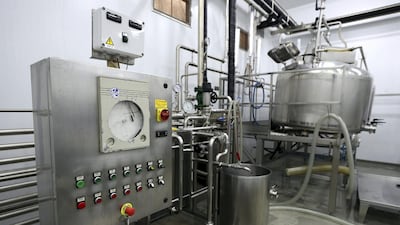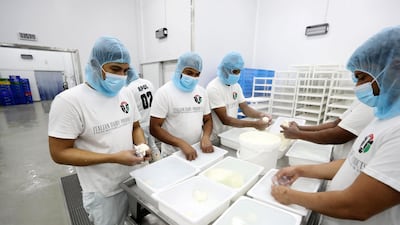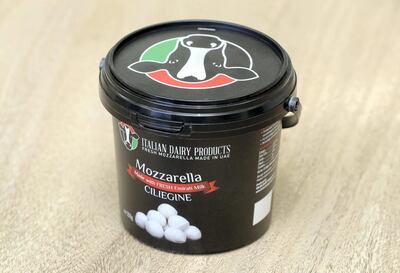Tucked away in Sharjah’s Hamriyah free zone is a most unexpected slice of Italy.
Behind the corrugated iron walls of the Italian Dairy Products factory, industrial churners run for hours each day producing fresh, creamy cheese.
From mozzarella to ricotta and burrata, the making, stirring and braiding of formaggio – Italian for cheese – is considered a fine art.
Leo Condemi, 48, and Silvia Angelotti, 46, are the dynamic duo behind the company, and their cheese is made the traditional Italian way, though mostly using UAE produce.
To see first-hand how it all comes together, The National took a tour of the site.
“Mozzarella is a staple of the Italian diet. We were brought up on it and you’ll find it in almost any fridge across the country,” Leo says.
“We use the same process and technique as they do back home.
“Our mission is simple; produce fresh cheese, day by day, without any preservatives."
Born and bred in Italy, the married couple started IDP in 2010. Before that, they ran a computer business.
“We came to Dubai for a holiday in 2008 and went to dinner with some locals,” Leo says.
"Nearly every table in the restaurant ordered caprese salad, which is made with mozzarella.
"We just thought, 'why not bring the fresh product here? The kind of product we eat in Italy. The real, fresh stuff.'"
More than a decade later, the factory now produces more than 420 tonnes of cheese each year.
The cheese is distributed to shops, hotels and homes across the UAE, Kuwait and Saudi Arabia.
Hailing from opposite sides of the country, there is some friendly rivalry between the couple when it comes to whose native cheeses are best.
"I'm from Milan in the north," Silvia says.
“For us, burrata, which is made from mozzarella and cream, is only eaten in the summertime and we use cow’s milk to produce the mozzarella.
“In the south, where Leo is from, they use buffalo milk to make mozzarella.
“We always fight about which is best, but it’s a debate people from the north and south have been having for years. It will never end.”
The intricacies of cheese making
From 5am to 4pm, 18 workers pace the floors of the 900-square-metre production plant.
Mozzarella makes up the bulk of product made on-site, followed by burrata and ricotta – a curd made from cow milk whey left over from the production of other cheeses.
Each working day, the factory produces on average 1.5 tonnes of cheese in different shapes and sizes – from 10g up to 500g servings.
For each 1,000 litres of cow's milk, they can manufacture 140kg of mozzarella. And for 1,000 litres of buffalo milk – which is imported from Italy – the amount increases to about 300kg, as the fat content is three times higher than cow's milk.
Alessandro Nicotra, plant production manager and a fellow Italian, says the process is simple and requires little interference with the raw ingredients.
It all starts from blocks of curd – cagliata in Italian – which comes from milk when it is drained of its whey. Fresh curd is then chopped and kneaded in hot water and salt.
Each day starts with the 5am arrival of a delivery truck laden with up to 10,000 litres of raw cow's milk.
Produced at Marmum Dairy farm in Al Ain, it travels from udder to factory floor within a few hours.
"The first thing we have to do is check that the milk is suitable. We do that by checking the temperature, fat and pH levels," Alessandro says.
“If the temperature reads higher or lower than four degrees it gets sent back to the farm as we can’t use it.
“For fresh milk, the pH level should range between 6.65 to 6.75, then we get it down to about 5.2 after about one hour.
"The first step is pasteurisation, where we remove any pathogens from milk. For each 1,000 litres it takes about 12 minutes."
After that, the milk gets transferred to an industrial milk vat for churning, where the starter culture – good bacteria – is added.
The amount of culture added depends on the type of cheese they are making. The temperature is also adjusted for each type of cheese.
"After about 40 minutes, we add microbiological rennet, which is an enzyme that turns the milk from a liquid to a solid," Alessandro says.
“We then remove the churning tool and add a layered knife which cuts the cheese into small knots.
“After this, the product is transferred to a resting pot. For ricotta, we heat it up to about 90°C and it starts floating to the top; that’s your final product.”
For mozzarella, the curd is transferred to a cooker, or stretching machine, heated up to 85°C, then steeped in cold water, before being transferred to cold storage.
In terms of shelf life, fresh ricotta and burrata can keep for eight days, buffalo mozzarella for 15 days and mozzarella for pizza for up to 25 days.
The only product stored on-site is mozzarella for pizza. Everything else is sent out for delivery on the same day it is made.
Over the next few years, Leo and Silvia plan to expand the business and open a production plant in Saudi Arabia.
"Right now we have about 60 per cent of the market in the UAE, and we can increase that as there are more customers to sell to," Leo says.
"Demand is there – we just need to up our supply.
"At the start, we had a hard time convincing Italian chefs that our product was the real deal.
"Then they tasted it and the rest is history," Leo says.
"If we can convince Italians that our product is the best in the UAE, we can convince plenty of others."















